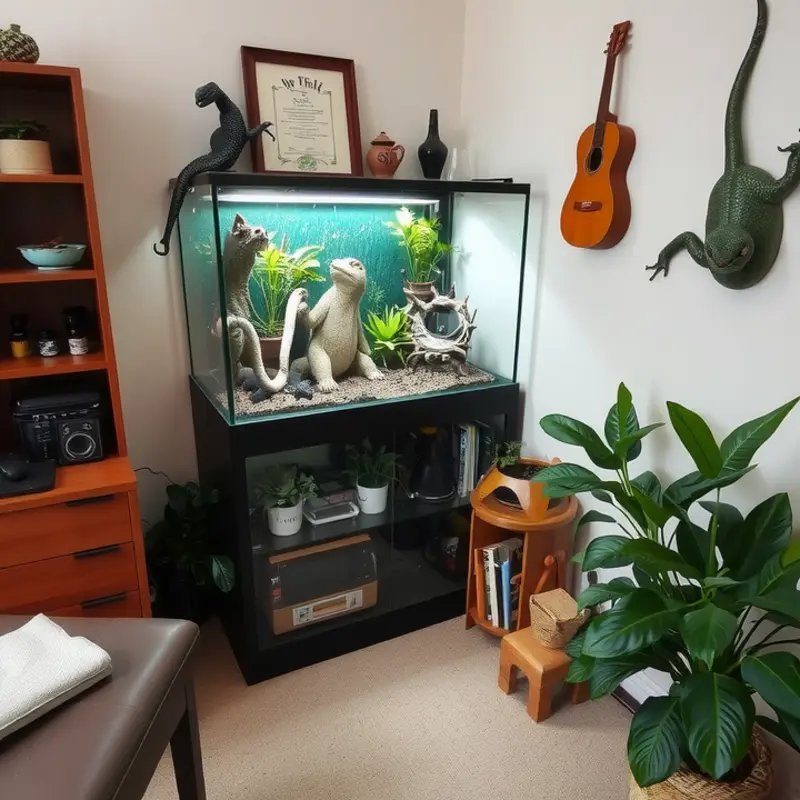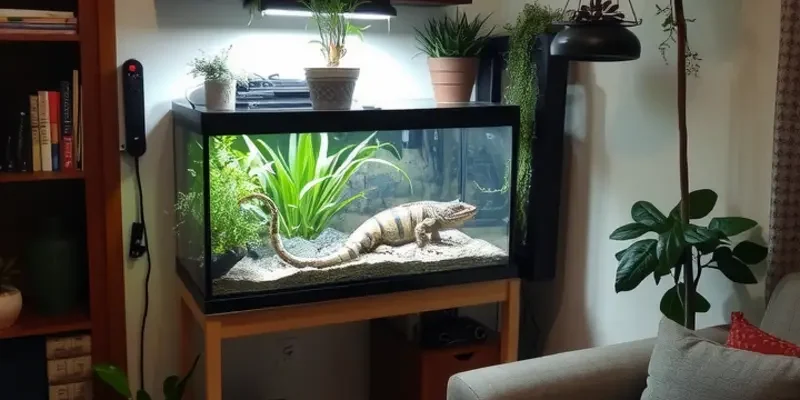Living in an apartment doesn’t mean you have to compromise on having a reptile as a pet. Families, couples, and pet enthusiasts can successfully provide an accommodating environment for reptiles, ensuring their comfort and safety. From choosing the right habitat to understanding their needs, reptile care can blend seamlessly with apartment living. This guide offers practical tips tailored for those living in family-friendly, pet-friendly spaces throughout the U.S. So whether you’re drawn to the cool looks of snakes, the unique charm of lizards, or the delightful presence of turtles, you’ll find step-by-step advice on creating a cozy home for your scaly friends. Let’s dive into the essentials of reptile care that work harmoniously in an apartment setting, ensuring that your living situation is both safe and enriching.
Designing an Ideal Habitat

Creating a tailored habitat for your reptile ensures its health and happiness, especially when space is limited in apartment settings. The first step in designing this space is to understand your reptile’s specific needs. Different reptiles have varied requirements when it comes to their environment, heating, and housing. Evaluate the size and species of your pet to determine the most suitable living arrangements.
For smaller reptiles, consider using terrariums that fit comfortably in your apartment without cluttering the space. Opt for vertical setups if your reptile enjoys climbing, as these can utilize the height of the room without sacrificing valuable floor area. For ground-dwelling reptiles, horizontal setups can be ideal, providing ample room for movement.
Temperature regulation is crucial in a reptile’s habitat. Reptiles are ectothermic, meaning they rely on external heat sources to regulate their body temperature. Invest in a quality heating device such as ceramic heat emitters or under-tank heaters to maintain optimal temperatures. Ensure that there are temperature gradients within the enclosure so your reptile can thermoregulate, moving to warmer or cooler areas as needed.
Lighting is another important factor. Many reptiles require ultraviolet (UV) light to synthesize vitamin D3, which is necessary for calcium metabolism. UVB lighting should be installed and set on a timer to mimic natural day/night cycles, preventing any stress induced by irregular light exposure.
Humidity also plays a significant role in reptile care. Research your reptile’s natural habitat and replicate those conditions as closely as possible. For species hailing from humid environments, misting systems or water features can help maintain moisture levels. Conversely, for species from arid regions, a dryer setup might be more appropriate. Managing humidity effectively also prevents respiratory issues and skin shedding problems.
Decor is not only aesthetic but functional, providing enrichment and comfort. Ensure that hideouts are available where reptiles can retreat to when they feel stressed. Branches, rocks, and plants (real or artificial) mimic their natural environment, making the enclosure a stimulating and safe space.
Finally, regular maintenance of the habitat is necessary. Clean the enclosure routinely, removing uneaten food and waste to prevent health issues. Check the functionality of all equipment and replace items as needed. By ensuring that your reptile’s habitat is well-maintained and thoughtfully designed, you create a safe haven where your scaly friend can thrive.
Healthy Diet and Care Routine

Reptiles bring an exotic touch to apartment life, but they require specific dietary regimens for optimal health. Understanding their unique needs is essential. Whether you’re housing a gecko or a python, respecting their feeding schedules and nutritional requirements ensures they thrive in your family-friendly abode.
A major aspect of reptile care is providing the correct balance of proteins, vitamins, and minerals. For insectivorous species such as geckos, feeding them a variety of live insects like crickets and mealworms ensures a balanced diet. When sourcing live foods, consider local pet stores, which often have a fresh supply. If you’re more adventurous, online platforms can deliver these straight to your door. This approach can align well with family activities—children often find observing live feedings educational.
Herbivorous reptiles, like iguanas, need a diet rich in leafy greens, fruits, and vegetables. Ensure these greens are washed thoroughly to remove any pesticide residue, which can be harmful to their health. Offering a mix of kale, collards, and dandelion greens creates a colorful, nutrient-dense meal. Keep a weekly schedule to help with meal prep, integrating it into your family’s routine.
For omnivorous reptiles, like some turtle species, balance is crucial. They thrive on a mix of insects and plant matter. Fish and shrimp can also be beneficial, but ensure these are free from contaminants. Incorporating these elements into your reptile’s diet requires occasional adjustments and observations of their health and behavior.
Vitamin and mineral supplements often play a pivotal role in maintaining reptile health. Calcium and vitamin D3 are vital for most reptiles to prevent metabolic bone disease. Dusting insects or plant matter with a quality supplement powder can provide these essential nutrients. This practice is easy to involve children, teaching them responsibility in measuring supplements correctly.
Maintaining cleanliness in your reptile’s habitat is equally important. A routine cleaning schedule reduces bacteria buildup and supports a healthy environment. Remove uneaten food promptly to avoid unpleasant odors, and make it a family habit to check enclosures daily. Spot cleaning can be a quick and efficient task that integrates smoothly into everyday chores.
When managing reptile waste, a DIY cleaning product can be safe and effective. Consider a vinegar and water solution to disinfect tanks and terrariums. Implement these practices as teachable moments with your family, showing the benefits of natural cleaning agents. You can follow guidelines for DIY apartment cleaning products to ensure safety and efficiency in your cleaning routine.
The commitment to a routine feeding and cleaning schedule is the foundation of good reptile care. It not only ensures their well-being but also enriches family dynamics, engaging everyone in the process of caring for a unique pet. By sustaining this routine, your reptile companions will continue to be a source of fascination and joy within your home.
Final words
Reptile care in an apartment is not only possible but can also be a fulfilling experience for families and pet enthusiasts. By designing an ideal habitat and maintaining a healthy care routine, you can ensure your reptile thrives in a cozy, comfortable space. Emphasizing safety and quality of life greatly enhances the bond between you and your scaly companion, ultimately enriching your family life. Remember, it’s about creating an environment where critters of all kinds can flourish alongside us, making our homes truly shared spaces.









